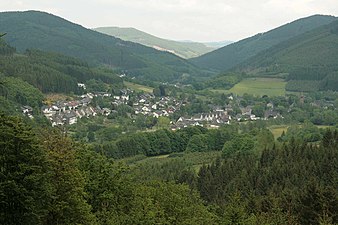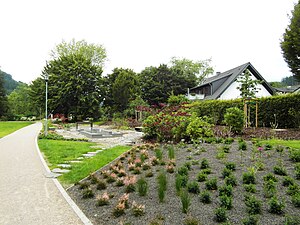Saalhausen (Lennestadt)
|
Saalhausen
City of Lennestadt
|
||
|---|---|---|
| Coordinates: 51 ° 7 ′ 3 ″ N , 8 ° 9 ′ 57 ″ E | ||
| Height : | 312 m | |
| Area : | 15.89 km² | |
| Residents : | 1760 (Jun 30, 2020) | |
| Population density : | 111 inhabitants / km² | |
| Incorporation : | 1st July 1969 | |
| Postal code : | 57368 | |
| Area code : | 02723 | |
|
Location of Saalhausen in Lennestadt |
||
|
View from the southeast
|
||
Saalhausen is a part of the Westphalia North Rhine- Olpe located Lennestadt with 1,760 inhabitants at June 30, 2020, with the proportion of seniors (over 65 years) with 20.1% is relatively high (proportion Lennestadt = 17.4%) .
Geographical location
Saalhausen is about two kilometers south of the Hohen Lehnberg, which belongs to the Saalhauser Mountains . It is located in the upper Lennetal between Altenhundem and Schmallenberg at an altitude of 320 m above sea level. Neighboring towns are Gleierbrück (W), Bracht (N), Störmecke (O) and Milchenbach (OSO). The federal road 236 runs through the village .
history
The name of the village is mentioned for the first time in the property register of Count Ludwig von Arnsberg (1281-1313). The Knight of Elspe owned an estate in Salehusen at that time. Saalhausen belonged to the parish Lenne from the original parish of Wormbach, mentioned in a document in 1072 .
The part of the name "hall" can linguistically be related to the old German word "sal" - house, hall. The origin of the name "Saalhausen" was probably derived from the word "Saal". "Hall" used to be the name of the seats of the small nobility (see Saalburg). This aristocratic seat was probably also in Saalhausen on the Schulten Hof. Its owner signed documents with the name "von Saalhausen". In a document from 1487 it was mentioned that a so-called castle hill with a moat and a castle square stood on this courtyard.
The treasury register (which was used to collect taxes) from 1543 shows 22 people who are subject to the treasury for Salhuißen (Saalhausen). If one equates the number of those liable to treasure with the number of existing families or houses and calculates 6 residents per house, around 130 people are likely to have lived in Saalhausen around 1540–1550.
In 1660 the plague broke out in the area around Saalhausen. On May 14, 1848, a fire broke out in the village and destroyed 33 buildings. From 1843 the parish of Saalhausen formed its own political municipality. The localities Saalhausen, Störmecke, Hilmeke and Gleierbrück belonged to the former municipality of Saalhausen. On July 1, 1969, the municipality in the city of Lennestadt was dissolved as a result of the municipal reform. At the end of 2020, the place had 1,760 inhabitants, whereby the proportion of senior citizens (over 65 years) is comparatively higher at 20.1% (average city of Lennestadt 17.4 %).
As early as the mid-1960s, the local council at that time made the decision to seek recognition of Saalhausen as a climatic health resort , which was achieved on December 18, 1973. Theo Heimes , then SPD member of the state parliament , accepted the recognition as a climatic health resort in Arnsberg .
From 1886 to 1967 there was a rail connection to Altenhundem and Wenholthausen .
religion
The old parish church of St. Jodokus probably came from the 14th century. At that time Saalhausen still belonged to the parish of Lenne. In 1780 the parish of Saalhausen asked the church authorities to set up its own pastoral care office. At that time Saalhausen counted 37 Solhöfe with around 200 inhabitants.
In February 1909 the old parish church, which was directly next to the Lenne , was under water. The building was severely damaged in the process. Subsequently, the residents of Saalhausen collected a total of 46,000 marks for the construction of a new church. Two collections brought in another 24,000 marks. On April 19, 1909, the old parish church was demolished.
Around six weeks later, on June 6, 1909, the foundation stone for the new church was laid. The design for the new St. Jodokus parish church, with a 42 meter high tower, came from Joseph Buchkremer . The new church was consecrated on October 11, 1910 by Bishop Karl Joseph Schulte . The total cost of the church, which is now a listed building, was 83,000 marks.
The high altar comes from the sculpture workshop of Peter Schneider from Eslohe. In the white marble base, it shows two Old Testament reliefs with the sacrifice of Isaac and the sacrifice of Melchizedek . In the wooden altarpiece there are four reliefs with scenes from the passion of Christ : the flagellation , the crowning of thorns , the carrying of the cross and Christ's encounter with his mother Mary.
Attractions
A sight in Saalhausen is the spa park with ponds, music pavilion and Kneipp facility. The spa park was embellished by the “talVital in Saalhausen” project implemented in 2015 (part of the “Lenneschiene” funding program). As part of this measure, new adventure points were created over 1.6 kilometers along the Lenne. The area around the music pavilion was also redesigned by expanding the adjacent pond and creating an island.
Picture gallery
View from the Kriegerweg
Web links
- Saalhausen
- Saalhauser messenger
- Saalhausen (Lennestadt) in the Westphalia Culture Atlas
Individual evidence
- ^ Population statistics for the city of Lennestadt
- ^ Johann Suibert Seibertz , Volume II, p. 113, No. 113
- ↑ Rosenberg, Bischöfliches Generalvikariat Paderborn, Brief history of the parish of Saalhausen , p. 9, based on sources by Josef Jacobsmeier, Paffer in Saalhausen, Josefs-Druckerei, Bigge, 1921
- ↑ The population of the Electoral Cologne Sauerland in 1543 (Treasury register 1543) ( Memento from October 3, 2011 in the Internet Archive )
- ^ Duchy of Westphalia State Archives IX. No. 74, Re. Dismenbartion by Lenne
- ↑ Rosenberg, Bischöfliches Generalvikariat Paderborn, Brief history of the parish of Saalhausen , p. 18, based on sources by Josef Jacobsmeier, Paffer in Saalhausen, Josefs-Druckerei, Bigge, 1921
- ↑ Martin Bünermann: The communities of the first reorganization program in North Rhine-Westphalia . Deutscher Gemeindeverlag, Cologne 1970, p. 90 .
- ^ Rosenberg, Bischöfliches Generalvikariat Paderborn, Brief history of the parish Saalhausen , p. 51
- ↑ Rosenberg, Bischöfliches Generalvikariat Paderborn, Brief history of the parish Saalhausen , p. 56
- ↑ Rosenberg, Bischöfliches Generalvikariat Paderborn, Brief history of the parish of Saalhausen , p. 58
- ↑ Ralf Breer and Otto Höffer, Churches and Chapels in Attendorn, Lennestadt and Kirchhuhndem, Attendorn 1999, p. 120
- ↑ "talVital Saalhausen," in publishing supplement "My Lennestadt" to output the Westfalenpost of 12 June 2015 Page 9
















